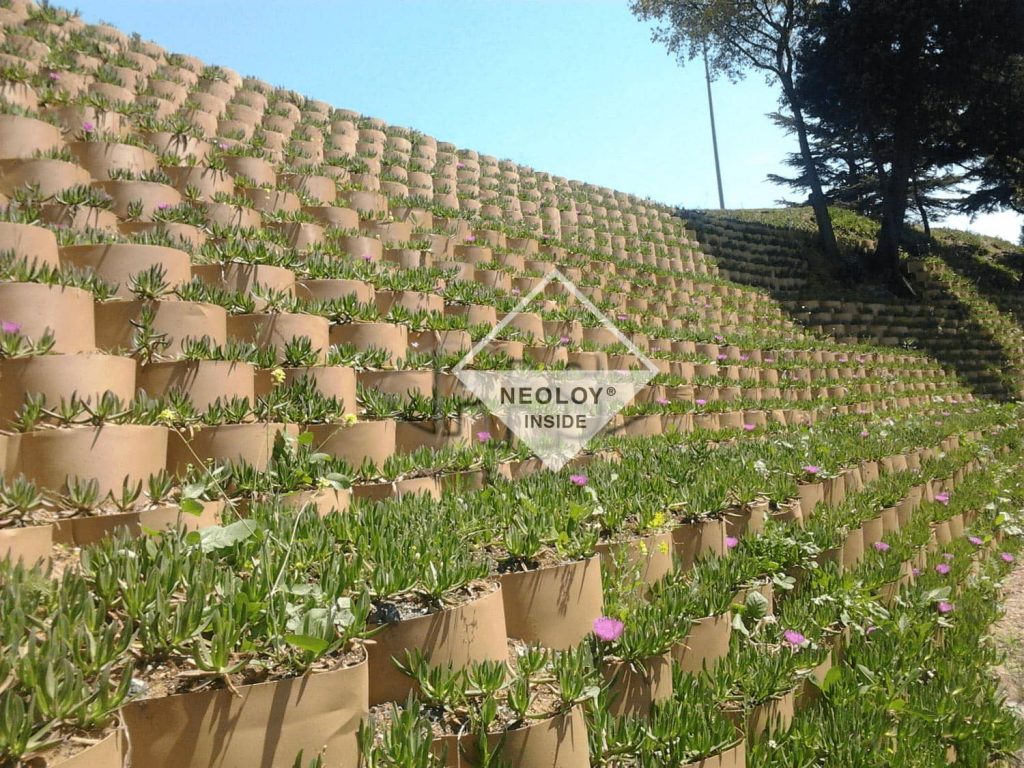
Landscaping
Tough Cell’s sustainable green building practices offer easily constructed landscape architectures, particularly those that support a natural environment., It can be used to reinforce base layers in roads, runway shoulders and parking lots, replacing hard armor paved surfaces with grass matts. This technique not only reduces heat dissipation (heat-island effect), but improves environmental aesthetics.
Read moreLandscaping
Neoloy® Geocells provide a cost-effective, sustainable, green solution what is an ideal solution for creating a micro-environment and the restoration of landscape aesthetics via the utilization of vegetation, slope and channel restoration, minimization of storm water damage, diminishment of urban heat island effects and the ability to use local recycled materials as infill. All these solutions are perfect for Low Impact Development (LID) and encouragement of green, environmentally oriented designs.
Sustainable Technique
Neoloy is the best-available sustainable solution for long-term soil protection and stabilization in slopes, embankments and retaining walls. The ability to utilize local soils and recycled materials saves aggregate resources, reduces truck hauling and decreases onsite earthworks.
Neoloy Geocells also improve site ecology by enhancing water drainage and soil quality, while the green fascia improves the site landscape and visual aesthetics. The vegetated fascia on the outer horizontal terraces/rows provides a soft green and aesthetic structure.
Additionally, perforations in the Neoloy cell walls promote infiltration and limit the impact of hydrostatic forces. The cells limit the impact of rain and run-off and preserve the soil structure and enabling the flow of water, nutrients and soil organisms.
Cost Effective
Reduced maintenance costs throughout lifecycle, initial construction savings – all equate to a cost-effective solution for landscaping
Engineering
Cell structure allows the use of native soils as infill and is sustainable even in harsh environmental conditions, including high temperature ranges, and UV radiation. It also promotes water infiltration and drainage, thus limiting soil erosion.
Installation
Reduction of heavy machine and project construction time is made possible by the fast and simple installation and the use of locally available infill material and the reduction of pavement thickness, made possible by Tough Cell. Environmental- Reduced aggregate requirements, concrete amounts and reduced hauling guarantee minimal environmental impact and reduction of the carbon footprint of the project.
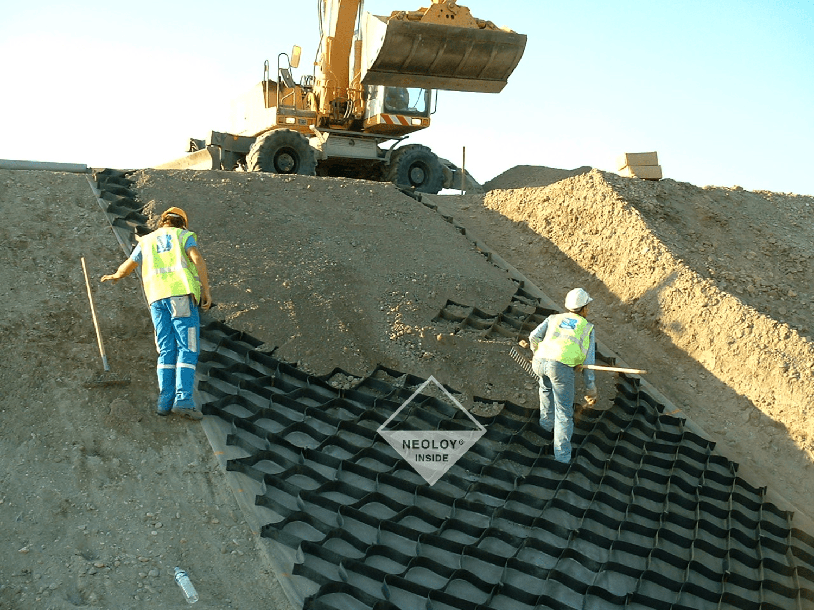
Earth Retention
Maapinna erosioonikindluse saavutamine, eriti sidumata pinnakihtide lagunemise ärahoidmine ja välispinna stabiilsuse tagamine, eeldab tavapäraselt väga vastupidavaid ja usaldusväärseid lahendusi. Kõiki mõjutegureid arvestava Neoloy Tough Cell`i geokärjega tugevdatud nõlvad on vastupidavad äärmuslikest temperatuuridest, UV-kiirgusest, oksüdatsioonist ja koormuspingetest põhjustatud lagunemisele.
Read moreEarth Retention
Neoloy® Geocells integrated reinforced retention and slope protection systems are used frequently for unstable, steep and or high slopes.
Earth retention applications usually require highly durable and reliable solutions, especially in regards to its stability and external facia. With this factored into the equation, Tough Cell creates reinforced geocell slopes with proven resistance to degradation caused from extreme temperatures, UV radiation, oxidation and load stresses.
Earth retention walls constructed from Tough Cell are strong, long lasting, easily installed, green solutions, utilized for steep slopes (up to 81⁰) with complex topography; they are available in stepped or vertical designs. The use of Tough Cell provides structural integrity even over soft subgrades and by using locally available soils as backfill material.
Integrated reinforced retention and slope protection systems are used frequently for unstable, steep and or high slopes. These slopes are typically part of road construction cut and fill earthworks with sharp grade changes or unstable slopes susceptible to landslides. In such projects the multiple advantages of Neoloy® Geocell earth stabilization are integrated into one comprehensive solution that combines Neoloy erosion control slope protection for stable slopes, with earth retention for unstable slopes.
With this innovative, green construction method, every Tough Cell can be an individual planter that contains vegetation, with its roots retaining soil substrate. Excellent drainage due to Tough Cell perforation along with dense vegetation provides a green landscape and environmental aesthetics.
There are three types of Tough Cell based retention walls suitable for different project types:
Gravity retaining walls – steep walls for earth erosion control, durable for external loads and self-weight.
Reinforced walls – earth stabilization for high retaining walls, reinforced with horizontal geogrids.
Integrated earth stabilization – a solution combining Tough Cell retaining walls and back slope cover protection
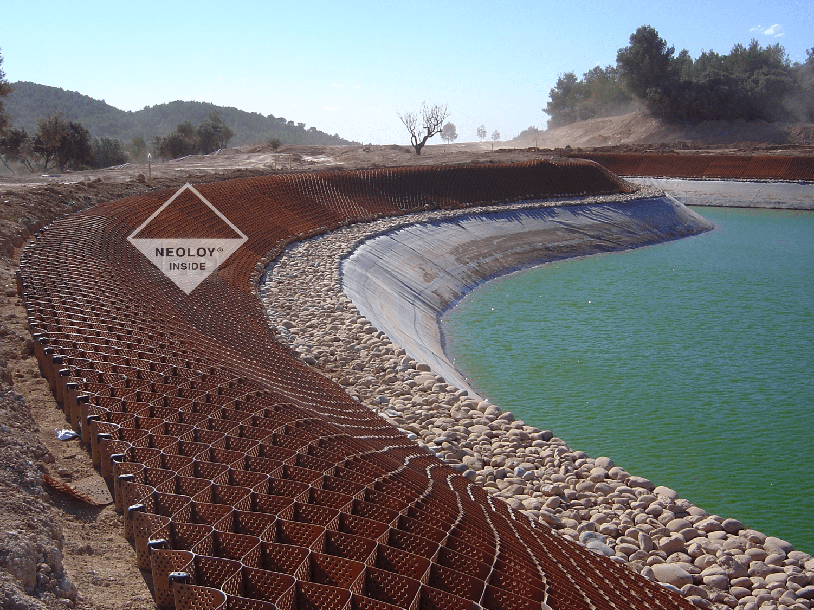
Reservoirs and Landfills
A crucial challenge of lined reservoirs is to protect its geomembrane, while simultaneously ensuring soil and slope stability. Tough Cell Geocells, with armor infill, provide the strength needed to succeed. Tough Cells made from Neoloy novel polymeric alloy are highly resistant to extreme weather conditions, corrosive materials and have very low polymeric creep.
Read moreReservoirs and Landfills
Tough Cell cellular confinement system is a reliable solution for reservoirs and landfills, including waste, and leachate impoundment. Tough Cell geocells are layered on top of a reservoir slope or pond geomembrane, filled with aggregate or concrete fill for long lasting protection against human or naturally caused damage.
The mission critical objective of reservoirs is to provide 100% protection of the reservoir geomembranes while creating stable soil, berms and slopes.
Neoloy cellular confinement from PRS combined with geomembranes creates protected, impermeable, non-slip and durable impoundment of water, waste and leachate. Liners are shielded by Neoloy Geocells from natural, accidental or intentional damage. Used in applications which require containment, treatment or control of water, or other liquids, Neoloy Geocells are installed on top of a geomembrane on the slopes of the reservoir or containment pond. The Neoloy Geocells are easily filled with concrete for effective and reliable long-term protection.
Conventional Solutions
Alternative solutions to create a uniform layer called for extensive subgrade replacement with a thick capping layer of quality aggregate. This solution was not cost-effective and does not deal with the high water table. Cement stabilization is too difficult to apply uniformly, its reliability over the long-term is questionable even in unsaturated conditions. Geogrids can not provide the same level of ground reinforcement and require imported higher cost aggregate.
The Tough Cell structure enhances a multitude of infill material behavior, successfully enabling the use of:
Concrete – Containment and treatment ponds. Using concrete is fast and efficient. The Tough Cell is laid in ready-made forms and finished with hard-armor in a uniform thickness – for the best results for every environment.
Gravel – Landfill drainage and leachate treatment.
Vegetated – Landfill covers, landscape rehabilitation and detention ponds.
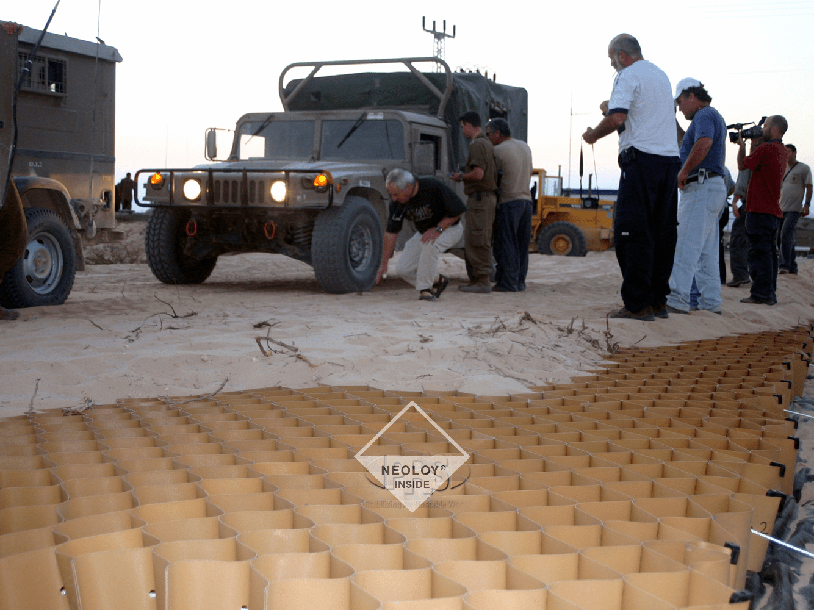
Emergency Infrastructure and Military
Restoring critical infrastructure is an objective that needs to be launched quickly and safely. Using the Tough Cell solution offers minimal logistics as well as the advantage of using local materials during time of necessity as a swiftly implemented and active construction process.
Read moreEmergency Infrastructure and Military
Neoloy Geocells can be used to construct temporary roads, landing strips, port platforms and earth retention in areas faced with rural disasters.
Using the Tough Cell solution offers minimal logistics as well as the advantage of using local materials during time of necessity as a swiftly implemented and active construction process.
Neoloy Geocells can be used to repair existing or construct temporary roads, landing strips, port platforms and earth retention or flood-protection walls in areas faced with rural disasters. Folded for easy logistics, Neoloy Geocells can be easily installed by local work crews and infilled with any local granular soil. Critical infrastructure can be constructed within a short time so that aid, personnel and equipment can reach the stricken regions and begin reconstruction.
Benefits
- Rapid creation or repair of emergency airstrips for airlifts
- Quickly restore roads and embankments for relief convoys and construction vehicles
- Heavy duty working platforms to stabilize damaged port platforms and container yards
- Stabilize and reinforce retention walls for unstable or failed slopes
- Flood retention walls for damaged reservoirs, dams or levees
- Rapid wall protection structures around relief organization compounds
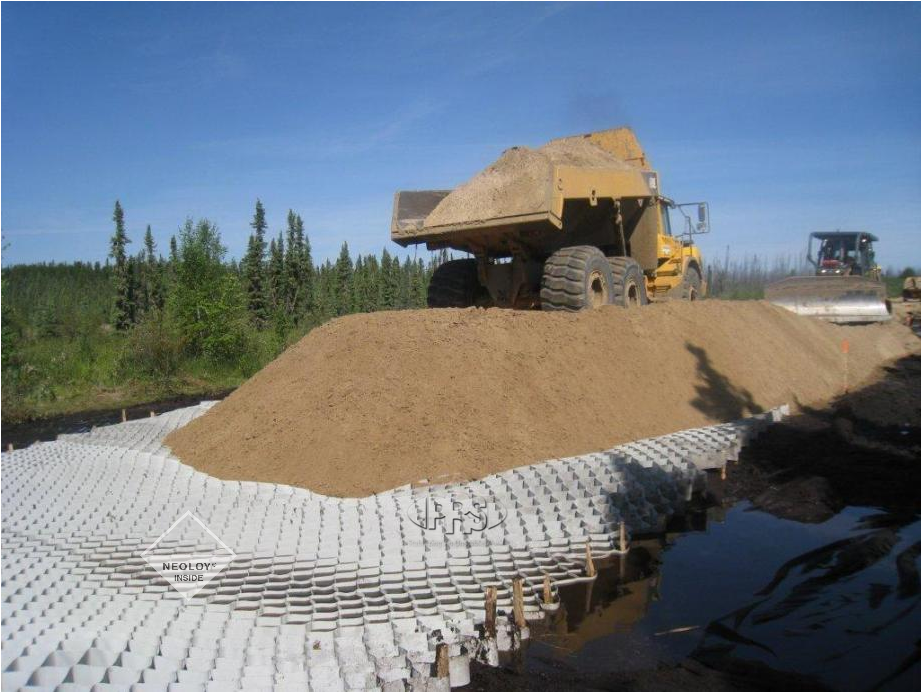
Load Support
Many work sites across the globe have limited accessibility due to huge areas covered with soft soils, meaning that the terrain cannot provide sufficient load support. Typical load support applications include reinforcement of base and subbase layers in flexible pavements, including: asphalt pavements, unpaved access, service and haul roads; military roads, railway substructure and ballast confinement; working platforms and so on.
Read moreLoad Support
Neoloy® Geocell Reinforcement in Load Support Applications. Neoloy is used for soil confinement, stabilization and reinforcement in a wide variety of load support and civil engineering applications, such as base reinforcement in paved and unpaved roads.
Neoloy enables the use of Neoloy Geocells for long-term load support infrastructure projects such as paved roads, railways and multi-modal ports. Geocell with Neoloy maintains its engineering characteristics and geometry for the project lifespan, even under dynamic loading, thermal cycling and high temperatures.
The 3D vertical zone of influence enables the use of poorly graded and fine granular materials, including local native soils, quarry sands, and recycled asphalt or concrete/cement rubble for heavy load support applications such as heavy traffic pavements and railway substructures.
Even a layer of Tough Cell geocells improves the bearing capability by creating a beam-effect. In extreme cases (e.g. CBR < 0.5%) another layer can be added as a sacrificial layer to help support the structure. . This effect acts as a semi-rigid mat, ensuring that swelling or seasonal changes, have little influence on the upper layers. In addition, the mechanical structure of the Tough Cell, along with the beam effect, distributes vertical stresses evenly, therefore enabling much greater load support.
To fine-tune and guarantee technology and safe construction scenarios, the MIF (Modulus Improvement Factor) of the Tough Cell structure was studied in the lab. During this time, it was proven to increase infill strength by 2-5 times, making it the best solution for heavy load support applications.
In conclusion, it’s a fact that soft soils with high water content or highly grained materials cause an engineering challenge. Other existing conventional solutions are very costly.
The Tough Cell is a proven, efficient and cost-effective solution for the transport of heavy haul equipment, while guaranteeing sufficient load support for your project – anytime, anywhere.

Slopes and Channels
The Tough Cell advanced three-dimensional erosion-control system is the best solution for any slope or channel when erosion is caused by streaming water, including shorelines beach heads, ports and other unprotected slopes. The Tough Cell geocell slope stabilization solution physically protects against erosive forces and is designed to enhance friction resistance to prevent soil migration.
Read moreSlopes and Channels
Stop soil erosion and the erosive impact of water in slopes, channels or reservoirs with Neoloy Geocells. Neoloy provides effective slope and channel protection and soil stabilization is suitable for any site, incline, and environmental conditions. Whether infilled with topsoil and vegetation for landscaping or with hard-armor surfacing for more severe pressures, Neoloy cellular confinement systems are the answer.
If you are looking for cost-effective, long-term slope protection for drainage ditches, channels, waterways and hydraulic structures, Neoloy Geoclls are the solution. Neoloy Geocells dissipate energy from flood, current and wave action and tolerate saturated conditions without losing structural stability. Vegetative and/or gravel surfaces are used for intermittent flooding while concrete infill is used for non-erodible channel protection.
Subsequently, Tough Cell slope stabilization methods guarantee durable, proven solutions for slopes while offering various cover options, determined by the project’s nature, channel geometry and hydraulic conditions, including:
Topsoil – Landscaping
One of the Tough Cell slope stabilization methods, makes use of local soil as infill. Tough Cell’s perforated wall design encourages plant growth, thus creating an interlock by using the rooted soil to ensure even greater root mass reinforcement. The same perforations optimize water drainage by limiting hydrostatic buildup. Using topsoil protects the environment and is a cost-effective solution that are more effective solutions than riprap, gabions or erosion control blankets.
Note: This solution is suitable for up to 6.5 m/sec flow velocity.
Granular – Shorelines and Landfills
Natural river banks and shorelines sometimes need riverscape engineering to protect them from erosive forces. By using crushed stone or gravel infill, Tough Cell provides effective protection for slopes/channels and shorelines that are exposed to hydraulic forces, such as ice, wind and water. In addition, Tough Cell can provide geomembrane protection in reservoirs. And landfill drainage systems.
Note: This solution is suitable for up to 3.5 m/sec flow velocity.
Hard Armor – Drainage Trenches and Channels
Tough Cell offer cost-effective, long-term slope protection for channels and road drainage ditches. Use of concrete infill is the preferred choice when dealing with high flows and stresses, such as bottom highway slope trenches where storm water causes intensive run-off. In channel retention cases, only cells subject to high flow rates are filled with concrete while other cells can be filled with granular crushed stone.
Note: This solution is suitable for up to 13.0 m/sec flow velocity.





